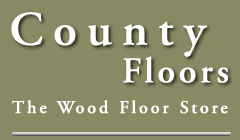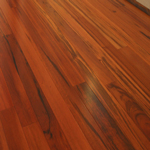Serving Upstate NY—VT—MA • For selections & prices, CALL or EMAIL US
Tigerwood (Goncalo Alves)
Grades & Properties of Wood Flooring —
Exotic Species
Scientific Name:
Astronium fraxinifolium
Other Common Names and Related Species:
- Bois de zèbre
- Bossona
- Goncalo Alves
- Kingwood
- Mura
- Urunday-para
- Zebrawood (not to be confused with African Zebrawood)
- Zorrowood
Shop online now for Tigerwood Flooring »
Origin:
Tigerwood is distributed through South America, including Uruguay, Paraguay, and Brazil.
Janka Hardness: 1850
Tigerwood has about the same hardness as Hickory and Purpleheart. It is 4% softer than Merbau, 27% harder than hard Maple, and 84% as hard as Santos Mahogany.
Grades of Tigerwood Flooring:
Clear grade Tigerwood flooring is color-sorted for a rich pink color with pronounced brown and black streaks. It is graded differently than most other species. Usually color variation is sorted out, but with Tigerwood the streaks are most desired. Normally, lesser grades such as #1 Common refer to the instance of small milling defects or lack of streaks.
Tigerwood Flooring Dimension Specifications:
All Tigerwood flooring is milled in South America because it is more cost-effective to ship finished material than raw lumber. Lengths of the Tigerwood flooring bundles are 7 feet so they can easily fit into 8-foot-wide steel shipping containers. All pre-milled products are tongue-&-groove and end-matched (tongue-&-grooved on the ends of the boards). Moisture content ranges from 6% to 8% for quick acclimation. The average length of the flooring pieces is usually about 3 feet and ranges from 1 to 7 feet. Almost all imported flooring that is found is in 7-foot bundles, with widths available from 2¼″ to 5″. Typically, if a long or wide plank floor is desired, raw lumber must be obtained and the flooring must be milled here in the United States. Typically, the lengths can develop up to 12 feet. However, the cost can be double that of the pre-milled stock because of waste and labor costs in the United States. Also, raw lumber is relatively expensive because it is taxed more heavily than finished products to support local economies in South America.
Flooring Availability:
Tigerwood is available in solid unfinished and prefinished solid for nail-down applications on wood and in engineered with a veneer top layer for application on concrete. Tigerwood is readily available in comparison with many Brazilian species such as Brazilian Cherry. There is a large amount of Tigerwood in South America, and it is not endangered. However, less logging, stricter regulations, and a slower American economy have slightly limited commodities and caused slightly higher prices of this product in this country.
Finished Floor Appearance:
A Clear grade floor will have a busy striped appearance. Tigerwood flooring darkens dramatically with sunlight from a pink to deep red color. Oil-based finishes allow Tigerwood to age to a deep brown color, unless lacquer or de-waxed shellac is first applied to help preserve the pink color of the wood. Water-based finishes will preserve the natural color longer.
Flooring Durability and Stability:
Tigerwood flooring is extremely durable and resists denting and traffic wear quite well. It is much harder than North American species because of its density and is relatively stable. Tigerwood flooring is very heavy, weighing over 3 pounds per square foot.
Workability of Tigerwood Flooring:
Although extremely hard and tough, Tigerwood works with limited difficulty with both hand and power tools. When installing the Tigerwood flooring, it is best to use a manual nailer, but staples and pneumatic nailers can be used. It holds screws well, and it glues, stains, and polishes to a very attractive finish. It can be somewhat difficult to sand with flooring equipment because of its hardness. Professional sanding and finishing is recommended. This wood is very resistant to decay and insects; these resistant properties may contribute to a possible allergic response to the dust. To avoid a possible allergic reaction to the material, wear a dust mask and long-sleeve shirt when working with Tigerwood.
Principal Uses of Tigerwood Flooring:
Tigerwood flooring is used in medium- and high-end residential and commercial applications for a dramatically elegant floor. It works well in rustic camps as well as in contemporary structures. There is no other floor that is similar. African Zebrawood is the only other species with as many streaks, but it is tan and black.





